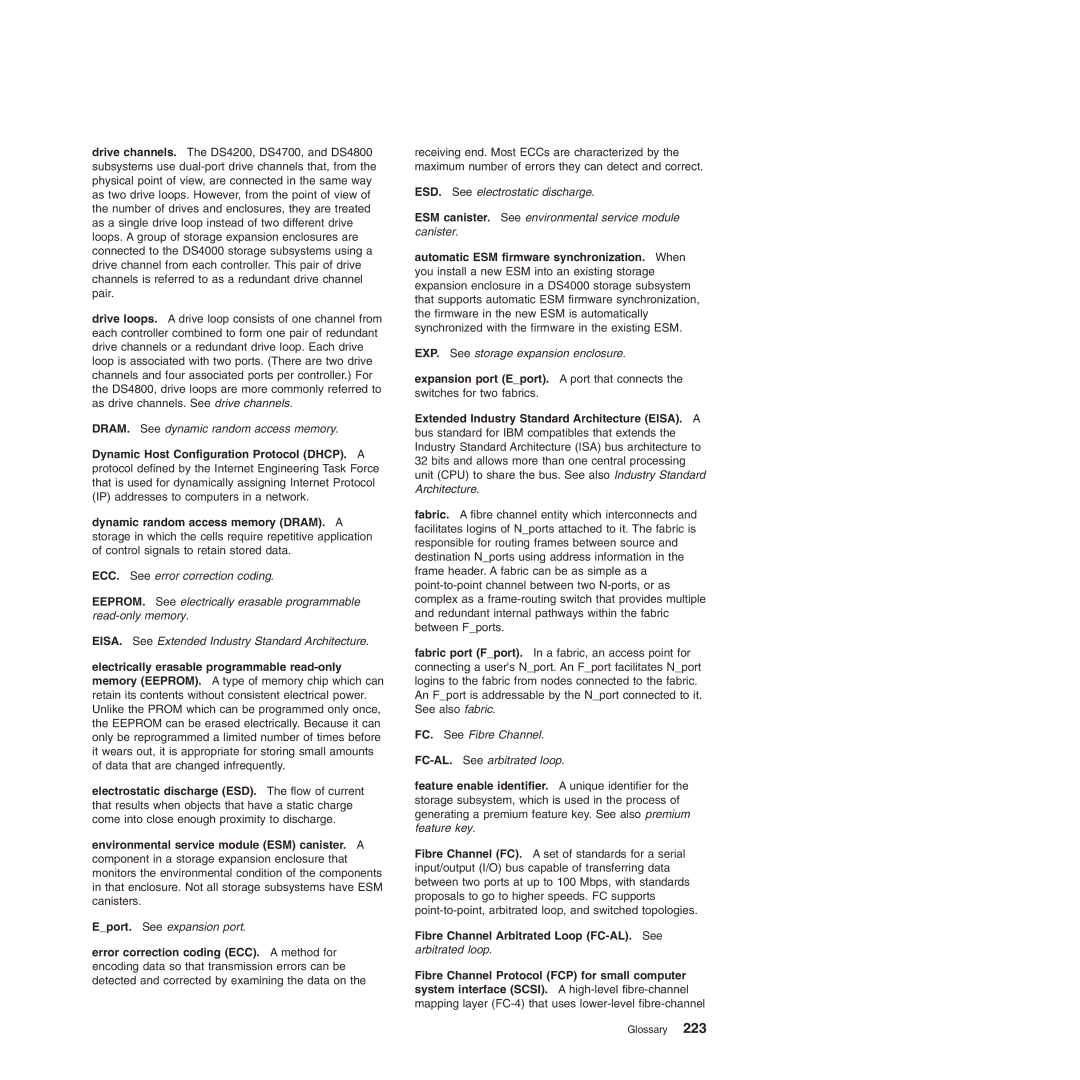drive channels. The DS4200, DS4700, and DS4800 subsystems use
drive loops. A drive loop consists of one channel from each controller combined to form one pair of redundant drive channels or a redundant drive loop. Each drive loop is associated with two ports. (There are two drive channels and four associated ports per controller.) For the DS4800, drive loops are more commonly referred to as drive channels. See drive channels.
DRAM. See dynamic random access memory.
Dynamic Host Configuration Protocol (DHCP). A protocol defined by the Internet Engineering Task Force that is used for dynamically assigning Internet Protocol (IP) addresses to computers in a network.
dynamic random access memory (DRAM). A
storage in which the cells require repetitive application of control signals to retain stored data.
ECC. See error correction coding.
EEPROM. See electrically erasable programmable
EISA. See Extended Industry Standard Architecture.
electrically erasable programmable
electrostatic discharge (ESD). The flow of current that results when objects that have a static charge come into close enough proximity to discharge.
environmental service module (ESM) canister. A
component in a storage expansion enclosure that monitors the environmental condition of the components in that enclosure. Not all storage subsystems have ESM canisters.
E_port. See expansion port.
error correction coding (ECC). A method for encoding data so that transmission errors can be detected and corrected by examining the data on the
receiving end. Most ECCs are characterized by the maximum number of errors they can detect and correct.
ESD. See electrostatic discharge.
ESM canister. See environmental service module canister.
automatic ESM firmware synchronization. When
you install a new ESM into an existing storage expansion enclosure in a DS4000 storage subsystem that supports automatic ESM firmware synchronization, the firmware in the new ESM is automatically synchronized with the firmware in the existing ESM.
EXP. See storage expansion enclosure.
expansion port (E_port). A port that connects the
switches for two fabrics.
Extended Industry Standard Architecture (EISA). A bus standard for IBM compatibles that extends the Industry Standard Architecture (ISA) bus architecture to 32 bits and allows more than one central processing unit (CPU) to share the bus. See also Industry Standard Architecture.
fabric. A fibre channel entity which interconnects and facilitates logins of N_ports attached to it. The fabric is responsible for routing frames between source and destination N_ports using address information in the frame header. A fabric can be as simple as a
fabric port (F_port). In a fabric, an access point for connecting a user's N_port. An F_port facilitates N_port logins to the fabric from nodes connected to the fabric. An F_port is addressable by the N_port connected to it. See also fabric.
FC. See Fibre Channel.
FC-AL. See arbitrated loop.
feature enable identifier. A unique identifier for the storage subsystem, which is used in the process of generating a premium feature key. See also premium feature key.
Fibre Channel (FC). A set of standards for a serial input/output (I/O) bus capable of transferring data between two ports at up to 100 Mbps, with standards proposals to go to higher speeds. FC supports
Fibre Channel Arbitrated Loop (FC-AL). See
arbitrated loop.
Fibre Channel Protocol (FCP) for small computer system interface (SCSI). A
mapping layer
Glossary 223
